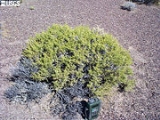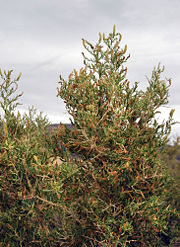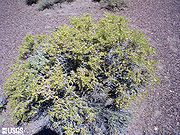
Greasewood
Encyclopedia
Greasewood, Sarcobatus, is a genus of one or two species
of flowering plant
s. Traditionally it has been treated in the family
Chenopodiaceae
, but the APG II system
, of 2003, places it in the family Sarcobataceae
.

 The Sarcobatus plants are deciduous
The Sarcobatus plants are deciduous
shrub
s growing to 0.5–3 m tall with spiny
branches and succulent leaves
, 10–40 mm long and 1–2 mm broad. The leaves are green, in contrast to the grey-green color of most of the other shrubs within its range. The flowers are unisexual and appear from June to August. The species reproduces from seeds and sprouts. The green or tan fruit is small and winged. Small brown seeds are contained inside the fruit.
The Sarcobatus area of distribution is western North America
, from southeastern British Columbia
and southwest Alberta
, Canada
south through the drier regions of the United States
(east to North Dakota
and west Texas
, west to central Washington and eastern California
) to northern Mexico
(Coahuila
).
Greasewood is a halophyte
, and is commonly found in sunny, flat areas around the margins of playa
s and in dry stream beds and arroyos. It is replaced by iodine bush in extremely saline environments, such as hummocks within the playa itself. Greasewood often grows in extensive, nearly pure stands in pluvial desert locations. Greasewood does not grow exclusively in highly saline areas, but is most common on fine-grained soils in areas with a relatively high water table.
Although it can be grazed by animals that are adapted, grazing of greasewood by sheep and cattle can result in oxalate poisoning resulting in kidney failure http://www.ivis.org/special_books/Knight/chap7/chapter_frm.asp?LA=1#Greasewood. The active agent can be either sodium oxalate or potassium oxalate. Sheep are the most vulnerable. Greasewood was commonly used for firewood by Native Americans and early settlers.
 The name Sarcobatus comes from Greek
The name Sarcobatus comes from Greek
sarko (meaning flesh) and batos (meaning bramble), referring to the species' spiny branches and succulent leaves.
The two species are:
Species
In biology, a species is one of the basic units of biological classification and a taxonomic rank. A species is often defined as a group of organisms capable of interbreeding and producing fertile offspring. While in many cases this definition is adequate, more precise or differing measures are...
of flowering plant
Flowering plant
The flowering plants , also known as Angiospermae or Magnoliophyta, are the most diverse group of land plants. Angiosperms are seed-producing plants like the gymnosperms and can be distinguished from the gymnosperms by a series of synapomorphies...
s. Traditionally it has been treated in the family
Family (biology)
In biological classification, family is* a taxonomic rank. Other well-known ranks are life, domain, kingdom, phylum, class, order, genus, and species, with family fitting between order and genus. As for the other well-known ranks, there is the option of an immediately lower rank, indicated by the...
Chenopodiaceae
Chenopodiaceae
Chenopodiaceae were a family of flowering plants, also called the Goosefoot Family. They are now included within family Amaranthaceae. The vast majority of Chenopods are weeds, and many are salt and drought tolerant. A few food crops also belong to the family: spinach, beets, chard, quinoa, and...
, but the APG II system
APG II system
The APG II system of plant classification is the second, now obsolete, version of a modern, mostly molecular-based, system of plant taxonomy that was published in April 2003 by the Angiosperm Phylogeny Group. It was a revision of the first APG system, published in 1998, and was superseded in 2009...
, of 2003, places it in the family Sarcobataceae
Sarcobataceae
Sarcobataceae is the botanical name for a family of flowering plants. This name has only recently been published, and such a family has been recognized by very few taxonomists....
.


Deciduous
Deciduous means "falling off at maturity" or "tending to fall off", and is typically used in reference to trees or shrubs that lose their leaves seasonally, and to the shedding of other plant structures such as petals after flowering or fruit when ripe...
shrub
Shrub
A shrub or bush is distinguished from a tree by its multiple stems and shorter height, usually under 5–6 m tall. A large number of plants may become either shrubs or trees, depending on the growing conditions they experience...
s growing to 0.5–3 m tall with spiny
Thorns, spines, and prickles
In botanical morphology, thorns, spines, and prickles are hard structures with sharp, or at least pointed, ends. In spite of this common feature, they differ in their growth and development on the plant; they are modified versions of different plant organs, stems, stipules, leaf veins, or hairs...
branches and succulent leaves
Leaf
A leaf is an organ of a vascular plant, as defined in botanical terms, and in particular in plant morphology. Foliage is a mass noun that refers to leaves as a feature of plants....
, 10–40 mm long and 1–2 mm broad. The leaves are green, in contrast to the grey-green color of most of the other shrubs within its range. The flowers are unisexual and appear from June to August. The species reproduces from seeds and sprouts. The green or tan fruit is small and winged. Small brown seeds are contained inside the fruit.
The Sarcobatus area of distribution is western North America
North America
North America is a continent wholly within the Northern Hemisphere and almost wholly within the Western Hemisphere. It is also considered a northern subcontinent of the Americas...
, from southeastern British Columbia
British Columbia
British Columbia is the westernmost of Canada's provinces and is known for its natural beauty, as reflected in its Latin motto, Splendor sine occasu . Its name was chosen by Queen Victoria in 1858...
and southwest Alberta
Alberta
Alberta is a province of Canada. It had an estimated population of 3.7 million in 2010 making it the most populous of Canada's three prairie provinces...
, Canada
Canada
Canada is a North American country consisting of ten provinces and three territories. Located in the northern part of the continent, it extends from the Atlantic Ocean in the east to the Pacific Ocean in the west, and northward into the Arctic Ocean...
south through the drier regions of the United States
United States
The United States of America is a federal constitutional republic comprising fifty states and a federal district...
(east to North Dakota
North Dakota
North Dakota is a state located in the Midwestern region of the United States of America, along the Canadian border. The state is bordered by Canada to the north, Minnesota to the east, South Dakota to the south and Montana to the west. North Dakota is the 19th-largest state by area in the U.S....
and west Texas
Texas
Texas is the second largest U.S. state by both area and population, and the largest state by area in the contiguous United States.The name, based on the Caddo word "Tejas" meaning "friends" or "allies", was applied by the Spanish to the Caddo themselves and to the region of their settlement in...
, west to central Washington and eastern California
California
California is a state located on the West Coast of the United States. It is by far the most populous U.S. state, and the third-largest by land area...
) to northern Mexico
Mexico
The United Mexican States , commonly known as Mexico , is a federal constitutional republic in North America. It is bordered on the north by the United States; on the south and west by the Pacific Ocean; on the southeast by Guatemala, Belize, and the Caribbean Sea; and on the east by the Gulf of...
(Coahuila
Coahuila
Coahuila, formally Coahuila de Zaragoza , officially Estado Libre y Soberano de Coahuila de Zaragoza is one of the 31 states which, with the Federal District, comprise the 32 Federal Entities of Mexico...
).
Greasewood is a halophyte
Halophyte
A halophyte is a plant that grows where it is affected by salinity in the root area or by salt spray, such as in saline semi-deserts, mangrove swamps, marshes and sloughs, and seashores. An example of a halophyte is the salt marsh grass Spartina alterniflora . Relatively few plant species are...
, and is commonly found in sunny, flat areas around the margins of playa
Dry lake
Dry lakes are ephemeral lakebeds, or a remnant of an endorheic lake. Such flats consist of fine-grained sediments infused with alkali salts. Dry lakes are also referred to as alkali flats, sabkhas, playas or mud flats...
s and in dry stream beds and arroyos. It is replaced by iodine bush in extremely saline environments, such as hummocks within the playa itself. Greasewood often grows in extensive, nearly pure stands in pluvial desert locations. Greasewood does not grow exclusively in highly saline areas, but is most common on fine-grained soils in areas with a relatively high water table.
Although it can be grazed by animals that are adapted, grazing of greasewood by sheep and cattle can result in oxalate poisoning resulting in kidney failure http://www.ivis.org/special_books/Knight/chap7/chapter_frm.asp?LA=1#Greasewood. The active agent can be either sodium oxalate or potassium oxalate. Sheep are the most vulnerable. Greasewood was commonly used for firewood by Native Americans and early settlers.
Species

Greek language
Greek is an independent branch of the Indo-European family of languages. Native to the southern Balkans, it has the longest documented history of any Indo-European language, spanning 34 centuries of written records. Its writing system has been the Greek alphabet for the majority of its history;...
sarko (meaning flesh) and batos (meaning bramble), referring to the species' spiny branches and succulent leaves.
The two species are:
- Sarcobatus baileyi - CovilleFrederick Vernon CovilleFrederick Vernon Coville was an American botanist who careered in the United States Department of Agriculture , where he became Chief Botanist, and was the first director of the United States National Arboretum...
(syn. Sarcobatus vermiculatus var. baileyi (Coville) Jepson). NevadaNevadaNevada is a state in the western, mountain west, and southwestern regions of the United States. With an area of and a population of about 2.7 million, it is the 7th-largest and 35th-most populous state. Over two-thirds of Nevada's people live in the Las Vegas metropolitan area, which contains its...
, endemicEndemic (ecology)Endemism is the ecological state of being unique to a defined geographic location, such as an island, nation or other defined zone, or habitat type; organisms that are indigenous to a place are not endemic to it if they are also found elsewhere. For example, all species of lemur are endemic to the...
. Low shrub 0.5–1 m tall. Leaves hairy, 10–16 mm long. - Sarcobatus vermiculatus - (Hook.William Jackson HookerSir William Jackson Hooker, FRS was an English systematic botanist and organiser. He held the post of Regius Professor of Botany at Glasgow University, and was the first Director of the Royal Botanic Gardens, Kew. He enjoyed the friendship and support of Sir Joseph Banks for his exploring,...
) Torr.. Throughout the range of the genus. Shrub 1–5 m tall. Leaves hairless or only slightly hairy, 15–40 mm long.
- Note - These two species are not accepted as distinct by all authors; see the Flora of North America for further details.

